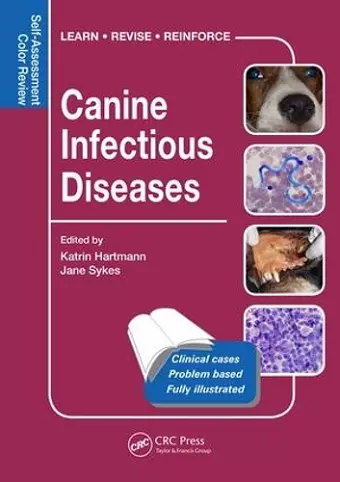Canine Infectious Diseases
Self-Assessment Color Review
Katrin Hartmann editor Jane Sykes editor
Format:Paperback
Publisher:Taylor & Francis Inc
Published:29th Mar '18
Should be back in stock very soon

This book covers all types of canine infectious diseases, including infections caused by viruses, bacteria, parasites and fungi. Over 200 clinical cases are presented randomly, as in practice, and cover the range of infectious diseases which affect all the organ systems of the dog. Featuring international expert contributors, the illustrated cases contain integrated questions and detailed explanatory answers.
The content and images are provided by renowned specialists at universities from around the world, and the text is clear, concise, and well written. Its premise of being a quick self-quizzing guide will make it an invaluable resource for veterinary students and review for experienced practitioners. Many of us understand diseases best through practice experience, and case-based learning, as presented in this book, is an effective and fun way to solidify knowledge about infectious diseases of dogs.
- Elizabeth E. Alvarez, DVM, DABVP, University of Wisconsin, USA in JAVMA Vol 253, Issue 6, September 2018
The cases in Canine Infectious Diseases provide multiple real-life examples that provide students with details of clinical history, physical examination and gross pathology, as well as images and explanations of the pinnacle histopathology that underpins the majority of second year content. Although the authors have described this book as being predominantly for working vets and students on fourth-year rotations, it is evident that the clinical cases described would additionally aid revision for earlier years of study; when learning general pathology (often in year 2 of the veterinary course), it is useful to relate the lectured theory content into clinical examples. Overall, I found this book easy to read and extremely useful for revising second-year pathology and relating theory to clinical examples. Many key diseases are described in detail and the use of diagnostic test results, especially histopathology, aids understanding. I will undoubtedly relate to Canine Infectious Diseases throughout the veterinary course, and the size of the handbook additionally makes it ideal for taking to clinical placements. The textbook could be made more extensive to cover the full-range of potential canine infections, which would help establish it as a recognised reference point for vets in practice and during studies. I would highly recommend Canine Infectious Diseases to any veterinary student with an interest in the subject of infectious disease, or undertaking placements or revision, as well as to graduated veterinary surgeons who may need to reinforce their knowledge.
- Kayleigh Hanlon, Second Year BVMSci Student at University of Surrey, published on WikiVet, Dec 2018
The case-based approach allows the details of each case to be provided step-by-step, similar to how they may appear in real practice. This allows an opportunity for both veterinarians and veterinary students to test existing knowledge and ponder the case. The color illustrations are an excellent addition, helping to identify classic and unique features of a condition, and also to create a more pleasurable learning experience. Each case is concise allowing the text to be picked up for short periods of study.
- Janeen Junaid, DVM, MVSc, VCA Bay Cities Animal Hospital, Burlington, Ontario in Can Vet J 2019; 60(10):1114
The content and images are provided by renowned specialists at universities from around the world, and the text is clear, concise, and well written. Its premise of being a quick self-quizzing guide will make it an invaluable resource for veterinary students and review for experienced practitioners. Many of us understand diseases best through practice experience, and case-based learning, as presented in this book, is an effective and fun way to solidify knowledge about infectious diseases of dogs.
- Elizabeth E. Alvarez, DVM, DABVP, University of Wisconsin, USA in JAVMA Vol 253, Issue 6, September 2018
The cases in Canine Infectious Diseases provide multiple real-life examples that provide students with details of clinical history, physical examination and gross pathology, as well as images and explanations of the pinnacle histopathology that underpins the majority of second year content. Although the authors have described this book as being predominantly for working vets and students on fourth-year rotations, it is evident that the clinical cases described would additionally aid revision for earlier years of study; when learning general pathology (often in year 2 of the veterinary course), it is useful to relate the lectured theory content into clinical examples. Overall, I found this book easy to read and extremely useful for revising second-year pathology and relating theory to clinical examples. Many key diseases are described in detail and the use of diagnostic test results, especially histopathology, aids understanding. I will undoubtedly relate to Canine Infectious Diseases throughout the veterinary course, and the size of the handbook additionally makes it ideal for taking to clinical placements. The textbook could be made more extensive to cover the full-range of potential canine infections, which would help establish it as a recognised reference point for vets in practice and during studies. I would highly recommend Canine Infectious Diseases to any veterinary student with an interest in the subject of infectious disease, or undertaking placements or revision, as well as to graduated veterinary surgeons who may need to reinforce their knowledge.
- Kayleigh Hanlon, Second Year BVMSci Student at University of Surrey, published on WikiVet, Dec 2018
The case-based approach allows the details of each case to be provided step-by-step, similar to how they may appear in real practice. This allows an opportunity for both veterinarians and veterinary students to test existing knowledge and ponder the case. The color illustrations are an excellent addition, helping to identify classic and unique features of a condition, and also to create a more pleasurable learning experience. Each case is concise allowing the text to be picked up for short periods of study.
- Janeen Junaid, DVM, MVSc, VCA Bay Cities Animal Hospital, Burlington, Ontario in Can Vet J 2019; 60(10):1114
ISBN: 9781482225150
Dimensions: unknown
Weight: 520g
272 pages